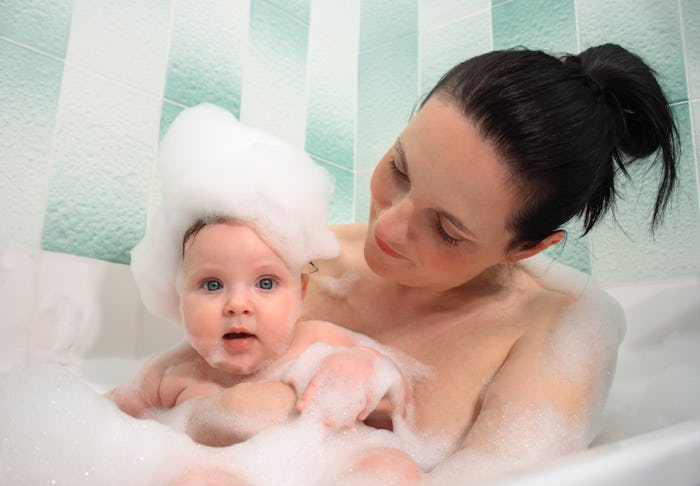Life

How To Co-Bathe With A Newborn & Make The Most Of Bath Time
Bringing your newborn home from the hospital can leave you overwhelmed, exhausted, and in serious need of a shower. Rather than stressing out about trying to figure out how to fit something as simple as bathing yourself into your routine, why not consider bathing with your baby? It's more than OK for you to shower or bathe with your child, and knock out two baths at the same time while promoting some major bonding between you and your babe. But co-bathing with your baby isn't quite as simple as hopping in the shower yourself, so you'll need to know how to co-bathe with a newborn before you jump in.
According to Heidi Murkoff, author of What to Expect When You're Expecting, you want to be sure to wait until your baby is old enough to co-bathe. It's important not to submerge your baby in water until their umbilical cord falls off and their navel has healed. Until this point, you can give your baby sponge baths, but wait to introduce co-bathing until their belly button has completely healed, so that you avoid any risk of infection. Once you're ready to co-bathe, you'll want to pay attention to water temperature. The same way you choose water temperature for bathing your baby, you'll want to choose an appropriate water temperature for you and your baby. According to the U.S. Consumer Product Safety Commission, you'll want the water between 90 and 100 degrees.
Before you even turn the water on, gather everything you'll need for the affair. From body wash, to baby shampoo, to extra washcloths and towels, registered nurse Nancy Holtzmann recommended on her site that you get all of your supplies together before you get into the shower, so that you're well prepared, and don't have to exit or enter the tub or shower mid-way through co-bathing.
Exiting and entering the tub safely is also extremely important. Dr. William Sears told Parenting that you'll want to enter the tub on your own at first, to avoid slipping or falling with your baby in your arms. This also gives you a good chance to test the water temperature and get situated. Ideally, your partner will hand your child to you once you're ready. But if you're working alone, you can place your child in their car seat (or bouncy seat, or other type of seat) beside the bath while you get in, and then reach over to retrieve them. When exiting the tub, perform the same thing in reverse. You may even want to lay a nonslip mat in your tub to prevent any unnecessary slipping during your co-bathing experience.
In What To Expect When You're Expecting, Murkoff recommends keeping your baby wet and warm, by using a plastic cup to pour water over your baby's body from time to time in the bath, to keep them nice and warm. If you're showering with your baby, Baby Center recommends positioning yourself so that your baby's face is not in a direct stream of water, and keeping a dry towel within reach to wipe your baby's face gently if they get upset when they get wet or soapy.
Whether you prefer baths or showers, once your baby is healed from their umbilical cord, they can join you in the shower for a prime bonding experience.